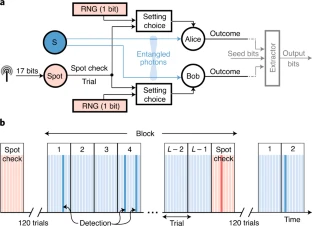Phys.org March 9, 2021
With the growing availability of experimental loophole-free Bell tests it has become possible to implement a new class of device-independent random number generators whose output can be certified to be uniformly random without requiring a detailed model of the quantum devices used. However, all these experiments require many input bits to certify a small number of output bits, and it is an outstanding challenge to develop a system that generates more randomness than is consumes. An international team of researchers (USA -University of Colorado, NIST, University of Maryland, Spain, Japan) developed a device-independent spot-checking protocol that consumes only uniform bits without requiring any additional bits with a specific bias. Implemented with a photonic loophole-free Bell test, they can produce 24% more certified output bits than consumed input bits. The experiment ran for 91.0 h, creating randomness at an average rate of 3,606 bits. According to the researchers their system allows for greater trust in public sources of randomness, such as randomness beacons and may one day enable high-quality private sources of randomness as the device footprint shrinks…read more. TECHNICAL ARTICLE

Schematic of the experiment and trial structure. Credit: Nature Physics (2021)